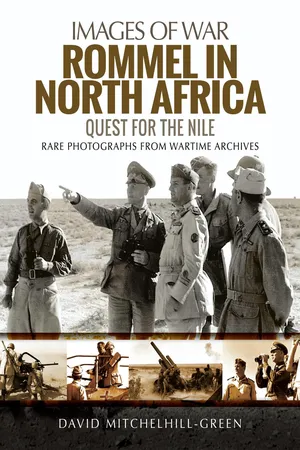
- 232 pages
- English
- ePUB (mobile friendly)
- Available on iOS & Android
About this book
Erwin Rommel is the arguably the most well-known German general of the Second World War. Revered by his troops and applauded by his enemies, the so-called Desert Fox achieved legendary status for his daring exploits and bold maneuvers during the North African campaign. In this book, richly illustrated with over 400 images, the author examines the privations and challenges Rommel faced in leading his coalition force.Endeavoring to reach the Nile Delta, we find Rommel's Axis soldiers poorly prepared to undertake such an audacious operation. Much-admired by his men in the front lines, we discover a demanding and intolerant leader, censured by subordinate officers and mistrusted by his superiors in Berlin. Certainly no diplomat, we observe posed interactions with Italian and junior German officers through an official lens.We note Rommel's readiness to take advantage of his enemy's weakness and study his extraordinary instinct for waging mobile warfare. We consider his disregard for the decisive factor of supply and view his army's reliance on captured equipment. We learn how this brave and ambitious commander was celebrated by German propaganda when the Wehrmacht's fortunes in the East were waning. Conversely, analyze why Winston Churchill honored him as a daring and skillful opponent. Finally, we picture this energetic, ambitious, at times reckless, commander as he roamed the vast Western Desert battlefield. This is the story of Rommel in North Africa.
Frequently asked questions
- Essential is ideal for learners and professionals who enjoy exploring a wide range of subjects. Access the Essential Library with 800,000+ trusted titles and best-sellers across business, personal growth, and the humanities. Includes unlimited reading time and Standard Read Aloud voice.
- Complete: Perfect for advanced learners and researchers needing full, unrestricted access. Unlock 1.4M+ books across hundreds of subjects, including academic and specialized titles. The Complete Plan also includes advanced features like Premium Read Aloud and Research Assistant.
Please note we cannot support devices running on iOS 13 and Android 7 or earlier. Learn more about using the app.
Information
Chapter One
Hitler’s Sunflower









Table of contents
- Cover
- Title
- Copyright
- Contents
- Acknowledgements
- Abbreviations
- Notes on Photographic Sources
- Introduction
- Chapter One Hitler’s Sunflower
- Chapter Two An Unfamiliar Land
- Chapter Three The ‘Desert Fox’
- Chapter Four Towards the Nile
- Chapter Five Kriegsgefangene (PoWs)
- Chapter Six Beutefahrzeuge
- Chapter Seven Artillery
- Chapter Eight Für Deutschland
- Bibliography